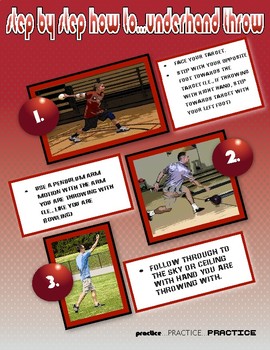
Make a cardboard target for the child to attempt to knock over. A rolled up sock is easy to handle, is unlikely to break anything and won’t roll far after being thrown. If you are teaching a very young child to throw overhand for the first time, consider using a rolled up sock and a cardboard target.

Here are a few popular overhand throwing games to help you get started:
UNDERHAND THROW LESSON PLAN HOW TO
Children need to learn how to perform overhand throws before they can play fun sports like Baseball, Cricket, Dodgeball and even Soccer (for throw-ins and goalkeeping). Over hand throwing is a fundamental part of many activities and sports. They will also learn the physical characteristics of different types of balls, developing an understanding how how they bounce and roll. Throwing games will help them quickly develop this skill. Many children struggle with timing when they are learning to throw and catch balls. They will also learn about other aspects of sports like fair play and being a good sport. They will learn to memorize rules and follow them as they play. This gives the children in the group an idea of what PE activities and organized sports are like. Throwing games are organized physical training sessions where children have to follow certain rules to play. Throwing games introduce children to sports and PE activities The development of both fine motor skills and gross motor skills in children is improved by playing throwing games regularly. Developing gross motor skills is essential for performing every day tasks like standing, walking, running, and jumping. Gross motor skills involve whole body movement and the engagement of larger muscles like those in the core. Developing fine motor skills gives children the dexterity necessary to perform complex tasks like picking up and arranging small objects. It allows a child to direct and control their limbs, making it possible to interact with objects in the physical world more easily.įine motor skills is the coordination of small muscles, like those in the fingers and hands, with the eyes. Throwing games improve hand-eye coordinationĭeveloping good hand-eye coordination is an essential part of a child’s development. Here are just a few of the advantages that children obtain by playing throwing games regularly. We’ll also offer a few tips for teaching children how to throw. To help you integrate throwing games into playtime, this guide will share 13 throwing games for kids. Throwing games will also help them improve their hand eye coordination, fine motor skills, and capacity for teamwork.


They will have a lot of fun with their friends while practicing their technique and seeing how other children throw. One of the easiest ways to help children become proficient throwers is by having them play throwing games. Most children will also require some instruction from a teacher or parent before they can throw, catch, and bounce balls accurately. However, like most mechanical skills, it does take a lot of practice to become a skilled thrower. It massively increases the number of fun activities that are available to them. Once a child has learned to throw accurately, they can begin to play many types of sports and activities including dodgeball, bocce ball and cricket. That’s why children need to learn how to throw as soon as possible, so they can participate in these activities with their friends. Throwing is a fundamental part of many different activities and sports. As an Amazon Associate, I earn from qualifying purchases.

Disclosure: This post may contain affiliate links, meaning I get a commission if you decide to purchase through my links, at no cost to you.


 0 kommentar(er)
0 kommentar(er)
